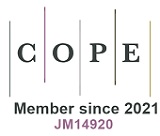Exon Array Analysis to Identify Diethyl-nitrosamine Differentially Regulated and Alternately Spliced Genes in Early Liver Carcinogenesis in the Transgenic Mouse ATT-myc Model
Downloads
Objectives: To identify the regulated genes or the spliced genes of diethylnitorsamine (NDEA) in ATT-myc mice versus control group. Methods: We analysed the 9 hybridizations on the MouseExon10ST array of NDEA treatments and control non- transgenic by application of a mixed model analysis of variance. Results: The 907 genes had regulated significantly between the groups and 916 genes had regulated with a significant exon-group interaction among of them 150 genes had regulated with both gene and possible splicing differences (p<0.01). The 7,618 genes had tested for the alternative gene up-regulation and splicing and compared to the gene-classifications. The genes functions, pathways and gene-classifications in the current study had presented in the contingency table analysis of the set of the regulated genes and alternatively spliced that regulated significantly in the ATT-myc mice treated by diethylnitorsamine versus control non-transgenic. The GOMolFn of gene-classification had 321 groups that had significantly regulated in the set of the regulated genes or differentially spliced. While the GOProcess of gene-classification had 330 groups that had significantly regulated in the set of differentially regulated genes or spliced. Additionally, the CELlLoc of gene-classification had 70 groups that had significantly regulated in the set of differentially regulated genes spliced. Finally, the Pathway gene-classification had 8 groups that had significantly regulated in the set of differentially regulated genes or spliced (p<0.01) in diethylnitorsamine when compared to control group. Conclusion: we summarized the toxicogenomics induced by diethylnitrosamine in early liver carcinogenesis in ATT-myc transgenic mice of liver cancer.
Doi:10.28991/SciMedJ-2021-0302-6
Full Text:PDF
Downloads
Griesenauer, R. H., & Kinch, M. S. (2017). An overview of FDA-approved vaccines & their innovators. Expert Review of Vaccines, 16(12), 1253–1266. doi:10.1080/14760584.2017.1383159.
Samuel M. Cohen, James Klaunig, M. Elizabeth Meek, Richard N. Hill, Timothy Pastoor, Lois Lehman-McKeeman, John Bucher, David G. Longfellow, Jennifer Seed, Vicki Dellarco, Penelope Fenner-Crisp, Dorothy Patton (2004). Evaluating the Human Relevance of Chemically Induced Animal Tumors. Toxicological Sciences, 78(2), 181–186. doi:10.1093/toxsci/kfh073.
Cohen, S. M. (2010). Evaluation of Possible Carcinogenic Risk to Humans Based on Liver Tumors in Rodent Assays. Toxicologic Pathology, 38(3), 487–501. doi:10.1177/0192623310363813
Rohrbeck, A., Salinas, G., Maaser, K., Linge, J., Salovaara, S., Corvi, R., & Borlak, J. (2010). Toxicogenomics Applied to In Vitro Carcinogenicity Testing with Balb/c 3T3 Cells Revealed a Gene Signature Predictive of Chemical Carcinogens. Toxicological Sciences, 118(1), 31–41. doi:10.1093/toxsci/kfq246.
Newell, P., Villanueva, A., Friedman, S. L., Koike, K., & Llovet, J. M. (2008). Experimental models of hepatocellular carcinoma. Journal of Hepatology, 48(5), 858–879. doi:10.1016/j.jhep.2008.01.008.
Iatropoulos, M. J., Jeffrey, A. M., Schlüter, G., Enzmann, H. G., & Williams, G. M. (2001). Bioassay of mannitol and caprolactam and assessment of response to diethylnitrosamine in heterozygous p53 -deficient (+/-) and wild type (+/+) mice. Archives of Toxicology, 75(1), 52–58. doi:10.1007/s002040000211.
Arai, T., Ogawa, T., Nakamura, M., Hosoya, M., & Ohnishi, Y. (2002). Changes in Hepatic Enzyme Activities in Transgenic Mice Carrying Human Prototype c-Ha-ras Gene Treated with Diethylnitrosamine. Journal of Veterinary Medical Science, 64(11), 1065–1067. doi:10.1292/jvms.64.1065.
Yamamoto, S., Mitsumori, K., Kodama, Y., Matsunuma, N., Manabe, S., Okamiya, H., … Hayashi, Y. (1996). Rapid induction of more malignant tumors by various genotoxic carcinogens in transgenic mice harboring a human prototype c-Ha-ras gene than in control non-transgenic mice. Carcinogenesis, 17(11), 2455–2461. doi:10.1093/carcin/17.11.2455.
Yamamoto, S., Urano, K., & Nomura, T. (1998). Validation of transgenic mice harboring the human prototype c-Ha-ras gene as a bioassay model for rapid carcinogenicity testing. Toxicology Letters, 102-103, 473–478. doi:10.1016/s0378-4274(98)00341-5.
Caviglia, J. M., & Schwabe, R. F. (2015). Mouse Models of Liver Cancer. Mouse Models of Cancer, 165–183. doi:10.1007/978-1-4939-2297-0_8.
Hueper, K., Elalfy, M., Laenger, F., Halter, R., Rodt, T., Galanski, M., & Borlak, J. (2012). PET/CT Imaging of c-Myc Transgenic Mice Identifies the Genotoxic N-Nitroso-Diethylamine as Carcinogen in a Short-Term Cancer Bioassay. PLoS ONE, 7(2), e30432. doi:10.1371/journal.pone.0030432.
Garcia, D., Warr, M. R., Martins, C. P., Brown Swigart, L., Passegue, E., & Evan, G. I. (2011). Validation of MdmX as a therapeutic target for reactivating p53 in tumors. Genes & Development, 25(16), 1746–1757. doi:10.1101/gad.16722111.
Mahmoud Elalfy and Juergen Borlak. (2020). Correlation of 18F-Fluorodeoxyglucose Glucose Uptake by Liver Cancer and Transcriptional Regulation of the Warburg Effects in ATT-MYC Mouse Model of Liver Cancer. Liver Research – Open Journal, (3)1, 1-8.
Farazi, P. A., & DePinho, R. A. (2006). Hepatocellular carcinoma pathogenesis: from genes to environment. Nature Reviews Cancer, 6(9), 674–687. doi:10.1038/nrc1934.
Liu, Y.-F., Zha, B.-S., Zhang, H.-L., Zhu, X.-J., Li, Y.-H., Zhu, J., … Zhang, J.-P. (2009). Characteristic gene expression profiles in the progression from liver cirrhosis to carcinoma induced by diethylnitrosamine in a rat model. Journal of Experimental & Clinical Cancer Research, 28(1), 107. doi:10.1186/1756-9966-28-107.
Creixell P, Reimand J, Haider S, Wu G, Shibata T, Vazquez M, et al. (2015). Pathway and network analysis of cancer genomes. Nature Methods, 12(7), 615–621. doi:10.1038/nmeth.3440
Thorgeirsson, S. S., & Grisham, J. W. (2002). Molecular pathogenesis of human hepatocellular carcinoma. Nature Genetics, 31(4), 339–346. doi:10.1038/ng0802-339.
Lee, J.-S., Chu, I.-S., Heo, J., Calvisi, D. F., Sun, Z., Roskams, T., … Thorgeirsson, S. S. (2004). Classification and prediction of survival in hepatocellular carcinoma by gene expression profiling. Hepatology, 40(3), 667–676. doi:10.1002/hep.20375.
Feitelson, M. A., Pan, J., & Lian, Z. (2004). Early molecular and genetic determinants of primary liver malignancy. Surgical Clinics of North America, 84(2), 339–354. doi:10.1016/s0039-6109(03)00226-3.
Michel, C., Desdouets, C., Slaoui, M., Isaacs, K. R., Roberts, R. A., & Boitier, E. (2007). Diethylnitrosamine Initiation Does Not Alter Clofibric Acid–Induced Hepatocarcinogenesis in the Rat. Toxicological Sciences, 99(1), 58–69. doi:10.1093/toxsci/kfm168.
Liu, Y.-F., Zha, B.-S., Zhang, H.-L., Zhu, X.-J., Li, Y.-H., Zhu, J., … Zhang, J.-P. (2009). Characteristic gene expression profiles in the progression from liver cirrhosis to carcinoma induced by diethylnitrosamine in a rat model. Journal of Experimental & Clinical Cancer Research, 28(1), 107. doi:10.1186/1756-9966-28-107.
Sheng, Z., Sun, Y., Zhu, R., Jiao, N., Tang, K., Cao, Z., & Ma, C. (2015). Functional Cross-Talking between Differentially Expressed and Alternatively Spliced Genes in Human Liver Cancer Cells Treated with Berberine. PLOS ONE, 10(11), e0143742. doi:10.1371/journal.pone.0143742.
Li, G., Ni, A., Tang, Y., Li, S., & Meng, L. (2020). RNA binding proteins involved in regulation of protein synthesis to initiate biogenesis of secondary tumor in hepatocellular carcinoma in mice. PeerJ, 8, e8680. doi:10.7717/peerj.8680.
Dong, L.-Y., Zhou, W.-Z., Ni, J.-W., Xiang, W., Hu, W.-H., Yu, C., & Li, H.-Y. (2016). Identifying the optimal gene and gene set in hepatocellular carcinoma based on differential expression and differential co-expression algorithm. Oncology Reports, 37(2), 1066–1074. doi:10.3892/or.2016.5333.
Wang, P., Ma, L., Jin, J., Zheng, M., Pan, L., Zhao, Y., … Xing, F. (2019). The anti-aflatoxigenic mechanism of cinnamaldehyde in Aspergillus flavus. Scientific Reports, 9(1). doi:10.1038/s41598-019-47003-z.
Liang, C., Zhang, Y., Zhang, Y., Li, R., Wang, Z., Wei, Z., & Guo, J. (2019). The prognostic value of LINC01296 in pan-cancers and the molecular regulatory mechanism in hepatocellular carcinoma: a comprehensive study based on data mining, bioinformatics, and in vitro validation. OncoTargets and Therapy, Volume 12, 5861–5885. doi:10.2147/ott.s205853.
Camalier, C. E., Young, M. R., Bobe, G., Perella, C. M., Colburn, N. H., & Beck, G. R. (2010). Elevated Phosphate Activates N-ras and Promotes Cell Transformation and Skin Tumorigenesis. Cancer Prevention Research, 3(3), 359–370. doi:10.1158/1940-6207.capr-09-0068.
Jin, H., Xu, C.-X., Lim, H.-T., Park, S.-J., Shin, J.-Y., Chung, Y.-S., … Cho, M.-H. (2009). High Dietary Inorganic Phosphate Increases Lung Tumorigenesis and Alters Akt Signaling. American Journal of Respiratory and Critical Care Medicine, 179(1), 59–68. doi:10.1164/rccm.200802-306oc.
Lin, Y., McKinnon, K. E., Ha, S. W., & Beck, G. R. (2014). Inorganic phosphate induces cancer cell mediated angiogenesis dependent on forkhead box protein C2 (FOXC2) regulated osteopontin expression. Molecular Carcinogenesis, 54(9), 926–934. doi:10.1002/mc.22153.
Sun, P., Ma, T., Zhang, T., Zhu, H., Zhang, J., Liu, Y., & Ding, J. (2019). Molecular basis for the function of the αβ heterodimer of human NAD-dependent isocitrate dehydrogenase. Journal of Biological Chemistry, 294(44), 16214–16227. doi:10.1074/jbc.ra119.010099.
Chow, W. A., Jiang, C., & Guan, M. (2009). Anti-HIV drugs for cancer therapeutics: back to the future? The Lancet Oncology, 10(1), 61–71. doi:10.1016/s1470-2045(08)70334-6.
Verschoor, M. L., Verschoor, C. P., & Singh, G. (2013). Ets-1 global gene expression profile reveals associations with metabolism and oxidative stress in ovarian and breast cancers. Cancer & Metabolism, 1(1), 17. doi:10.1186/2049-3002-1-17.
Abu-Remaileh, M., & Aqeilan, R. I. (2014). The tumor suppressor WW domain-containing oxidoreductase modulates cell metabolism. Experimental Biology and Medicine, 240(3), 345–350. doi:10.1177/1535370214561956.
Park, S. G., Schimmel, P., & Kim, S. (2008). Aminoacyl tRNA synthetases and their connections to disease. Proceedings of the National Academy of Sciences, 105(32), 11043–11049. doi:10.1073/pnas.0802862105.
Huang, D., Li, T., Li, X., Zhang, L., Sun, L., He, X., … Zhang, H. (2014). HIF-1-Mediated Suppression of Acyl-CoA Dehydrogenases and Fatty Acid Oxidation Is Critical for Cancer Progression. Cell Reports, 8(6), 1930–1942. doi:10.1016/j.celrep.2014.08.028.
Ngoka, L. C. (2008). Dramatic down-regulation of oxidoreductases in human hepatocellular carcinoma hepG2 cells: proteomics and gene ontology unveiling new frontiers in cancer enzymology. Proteome Science, 6(1), 29. doi:10.1186/1477-5956-6-29.
Jiang, W., Li, G., Li, W., Wang, P., Xiu, P., Jiang, X., … Jiang, H. (2018). Sodium orthovanadate overcomes sorafenib resistance of hepatocellular carcinoma cells by inhibiting Na+/K+-ATPase activity and hypoxia-inducible pathways. Scientific Reports, 8(1). doi:10.1038/s41598-018-28010-y.
Hönig, A., Auboeuf, D., Parker, M. M., O’Malley, B. W., & Berget, S. M. (2002). Regulation of Alternative Splicing by the ATP-Dependent DEAD-Box RNA Helicase p72. Molecular and Cellular Biology, 22(16), 5698–5707. doi:10.1128/mcb.22.16.5698-5707.2002.
Fitzgerald, M. E., & Drohat, A. C. (2008). Structural Studies of RNA/DNA Polypurine Tracts. Chemistry & Biology, 15(3), 203–204. doi:10.1016/j.chembiol.2008.03.001.
Zheng, B.-N., Ding, C.-H., Chen, S.-J., Zhu, K., Shao, J., Feng, J., … Xie, W.-F. (2019). Targeting PRMT5 Activity Inhibits the Malignancy of Hepatocellular Carcinoma by Promoting the Transcription of HNF4α. Theranostics, 9(9), 2606–2617. doi:10.7150/thno.32344.
Lyubetsky, V., Piel, W. H., & Quandt, D. (2014). Current Advances in Molecular Phylogenetics. BioMed Research International, 2014, 1–2. doi:10.1155/2014/596746.
Mohan, C. D., Bharathkumar, H., Bulusu, K. C., Pandey, V., Rangappa, S., Fuchs, J. E., … Rangappa, K. S. (2014). Development of a Novel Azaspirane That Targets the Janus Kinase-Signal Transducer and Activator of Transcription (STAT) Pathway in Hepatocellular Carcinoma in Vitro and in Vivo. Journal of Biological Chemistry, 289(49), 34296–34307. doi:10.1074/jbc.m114.601104.
Ohata, T., Yokoo, H., Kamiyama, T., Fukai, M., Aiyama, T., Hatanaka, Y., … Taketomi, A. (2017). Fatty acid-binding protein 5 function in hepatocellular carcinoma through induction of epithelial-mesenchymal transition. Cancer Medicine, 6(5), 1049–1061. doi:10.1002/cam4.1020.
Liang, J., Wen, J., Huang, Z., Chen, X., Zhang, B., & Chu, L. (2019). Small Nucleolar RNAs: Insight Into Their Function in Cancer. Frontiers in Oncology, 9. doi:10.3389/fonc.2019.00587.
Shimizu, Y., & Dobashi, K. (2012). CC-Chemokine CCL15 Expression and Possible Implications for the Pathogenesis of IgE-Related Severe Asthma. Mediators of Inflammation, 2012, 1–7. doi:10.1155/2012/475253.
Köbsel, N., & Ramadori, G. (1994). Human hepatoma cells synthesize and secrete lysozyme: Modulation by cytokines. Hepatology, 19(5), 1182–1188. doi:10.1002/hep.1840190516.
Cao, Y., Zhang, J., Xiong, D., Wang, D., Wu, T., Huang, A., & Tang, H. (2015). Hsa-miR-331-3p inhibits VHL expression by directly targeting its mRNA 3'-UTR in HCC cell lines. Acta Biochimica Polonica, 62(1). doi:10.18388/abp.2014_779.
Cao, D., Song, X., Che, L., Li, X., Pilo, M. G., Vidili, G., … Calvisi, D. F. (2016). Bothde novosynthetized and exogenous fatty acids support the growth of hepatocellular carcinoma cells. Liver International, 37(1), 80–89. doi:10.1111/liv.13183.
Songe-Møller, L., van den Born, E., Leihne, V., Vågbø, C. B., Kristoffersen, T., Krokan, H. E., … Klungland, A. (2010). Mammalian ALKBH8 Possesses tRNA Methyltransferase Activity Required for the Biogenesis of Multiple Wobble Uridine Modifications Implicated in Translational Decoding. Molecular and Cellular Biology, 30(7), 1814–1827. doi:10.1128/mcb.01602-09.
Endres, L., Fasullo, M., & Rose, R. (2019). tRNA modification and cancer: potential for therapeutic prevention and intervention. Future Medicinal Chemistry, 11(8), 885–900. doi:10.4155/fmc-2018-0404.
Arora, A. S., De Groen, P. C., Croall, D. E., Emori, Y., & Gores, G. J. (1996). Hepatocellular carcinoma cells resist necrosis during anoxia by preventing phospholipase‐mediated calpain activation. Journal of cellular physiology, 167(3), 434-442. doi.10.1002/(SICI)1097-4652(199606)167:3<434::AID-JCP7>3.0.CO;2-Q.
Chang, C.-C., Jeng, Y.-M., Peng, M., Keppeke, G. D., Sung, L.-Y., & Liu, J.-L. (2017). CTP synthase forms the cytoophidium in human hepatocellular carcinoma. Experimental Cell Research, 361(2), 292–299. doi:10.1016/j.yexcr.2017.10.030.
Lau, H.-K., Hsieh, M.-J., Yang, S.-F., Wang, H.-L., Kuo, W.-H., Lee, H.-L., & Yeh, C.-B. (2016). Association between Interleukin-18 Polymorphisms and Hepatocellular Carcinoma Occurrence and Clinical Progression. International Journal of Medical Sciences, 13(7), 556–561. doi:10.7150/ijms.15853.
Tucker, R. D., Ciofoaia, V., Nadella, S., Gay, M. D., Cao, H., Huber, M., … Smith, J. P. (2019). A Cholecystokinin Receptor Antagonist Halts Nonalcoholic Steatohepatitis and Prevents Hepatocellular Carcinoma. Digestive Diseases and Sciences, 65(1), 189–203. doi:10.1007/s10620-019-05722-3.
Paik, W. K., & Kim, S. (1980). Natural occurrence of various methylated amino acid derivatives. Protein methylation, 8-25.
Bedford, M. T., & Clarke, S. G. (2009). Protein Arginine Methylation in Mammals: Who, What, and Why. Molecular Cell, 33(1), 1–13. doi:10.1016/j.molcel.2008.12.013.
Lopez Sambrooks, C., Baro, M., Quijano, A., Narayan, A., Cui, W., Greninger, P., … Contessa, J. N. (2018). Oligosaccharyltransferase Inhibition Overcomes Therapeutic Resistance to EGFR Tyrosine Kinase Inhibitors. Cancer Research, 78(17), 5094–5106. doi:10.1158/0008-5472.can-18-0505.
- This work (including HTML and PDF Files) is licensed under a Creative Commons Attribution 4.0 International License.












